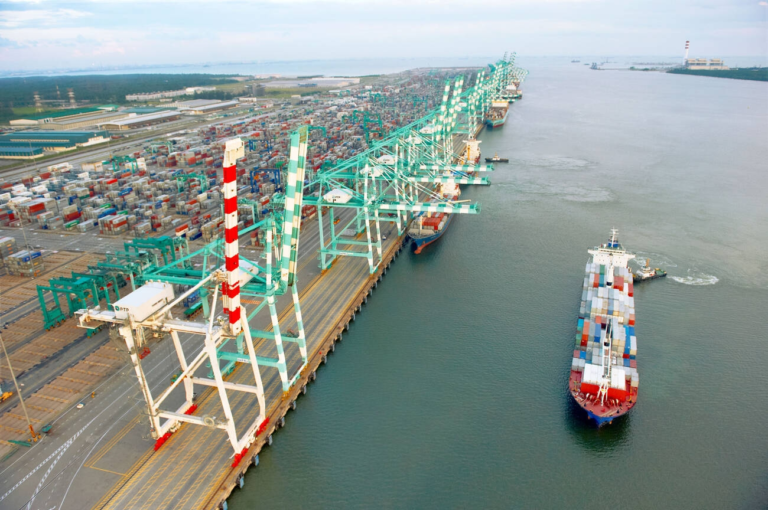The Significance of Dwell Time in Logistics
Every minute matters in the fast-paced field of logistics, where delays can have an impact on the entire supply chain. For this reason, dwell time, which is a seemingly straightforward idea, has enormous importance in the current transportation environment.
The whole amount of time a vehicle spends at a facility, usually while it is being loaded or unloaded, is referred to as dwell time. This might involve airplanes sitting on tarmacs, trucks waiting at warehouses, or containers loitering at ports. Even while dwell time can seem like a small issue, it can have a big effect on logistical processes.
In fact, the average container vessel dwell time in 2022 was anticipated to be 34.6 hours in the top 25 U.S. container ports alone, a notable rise of 2.6 hours from 2021. This increase draws attention to the increasing problem of dwell time, which exists not only in the US but also globally.
This blog delves further into dwell time and examines how it affects many aspects of logistics. We’ll examine methods to reduce dwell times, examine the effects of longer dwell times, and talk about how effective logisitics management eventually results in happier customers.
Unpacking the Impact of Dwell Time
Long dwell times can cause a series of delays and disturbances across your entire operation, even though they might not seem like much at first. For companies of all sizes, it is essential to comprehend the full impact of dwell time.
What Contributes to Dwell Time
Although dwell time seems simple, there are a lot of variables in the intricate realm of logistics that can influence it. Let’s examine the typical issues that lead to longer stay times and hinder efficient supply chain operations:
Inefficient On-Site Processes: Slow document processing, clumsy warehousing, and laborious check-in processes can all greatly prolong loading and unloading times. These problems may be made worse by inadequate departmental communication and inadequate training for dockworkers.
Arrival Delays and Unplanned Disruptions: Unexpected equipment failures, poor weather, and traffic congestion can all contribute to delays in car arrivals. These hiccups cause delays in the loading and unloading schedule and cause congestion at the facilities.
Imbalanced Workload: Staff and resources may be overworked if shipments are distributed unevenly throughout the day or week. Peak times can cause bottlenecks and prolong stay times for all parties involved when there are large volumes of commodities entering or leaving the country.
Complex Loads: Compared to trucks or containers delivering homogeneous cargo, those carrying mixed pallets holding orders for multiple clients require a lot more time to sort and distribute. Extended dwell durations result from the increased complexity, which demands more time and labour to manage.
Measuring the Cost of Dwell Time
Every extra minute a cargo sits idle when it comes to dwell time adds up to a number of hidden charges that can seriously hurt your bottom line. Let’s see how an extended stay can become costly:
Storage costs: Trailers and containers kept longer than the allotted free time are subject to costs from ports and warehouses. These costs result from longer stay times and can significantly reduce profitability, particularly for companies that handle large volumes of goods.
Demurrage and Detention Charges: Shipping lines frequently charge demurrage and detention fees for containers that are kept at ports past the designated free time. Likewise, trailers that are kept after their specified pick-up or drop-off times are subject to detention fees. These charges have the potential to be high and financially burdensome. To know more check out our detailed guide on demurrage and detention charges.
Increased Labour Costs: Shipments delayed by long dwell times lead to an accumulating increase in labour expenses. Truck drivers put in extra hours waiting to be loaded or unloaded, and warehouse employees might have to work overtime to clear backlogs. These additional costs can put a strain on your budget.
Reduced Equipment Utilization: Due to prolonged dwell durations, trucks, trailers, and containers become unavailable for use in other deliveries. As a result, your fleet operates less efficiently overall and you can’t execute orders on time. Under-utilizing equipment results in lost revenue opportunities.
Operational Delays: Excessive dwell time causes disruptions to meticulously crafted timetables. Delays at one point in the supply chain ripple outwards, causing disruptions throughout the entire network. This can lead to missed delivery deadlines, production slowdowns, and ultimately, unhappy customers.
Strategies for Reducing Dwell Time
After talking about how dwell times affect your operations and budget, let’s turn our attention to workable fixes. This section provides tips on how to improve your supply chain’s dwell time and process efficiency. Putting these strategies into practice can increase productivity, reduce costs, and improve customer satisfaction.
Leveraging Technology for Efficiency
Innovative approaches are being developed in today’s tech-driven society to address the persistent problem of dwell time. You can achieve large reductions in idle periods and unleash new levels of efficiency by carefully incorporating sophisticated technologies into your logistics operations. How to do it is as follows:
Advanced Tracking Systems: Tracking shipments in real time, from the point of origin to the destination, offers priceless information on their whereabouts and motion. In addition to ensuring resources are available as soon as they arrive and reducing waiting times for both trucks and warehouse staff, this enables proactive planning and modifications.
Warehouse Management Software (WMS): As the brains of your warehouse, a strong WMS maximizes resource allocation, inventory control, and order fulfilment. WMS can greatly simplify picking routes, automate tasks like putaway and replenishment, and easily integrate with tracking systems while significantly reducing dwell time within warehouse walls.
Automation & Robotics: Warehouse operations can be completely transformed by advanced automation solutions like robotic picking systems and automated storage and retrieval systems (AS/RS). These technologies quickly and precisely complete monotonous jobs, freeing up human labour to concentrate on more difficult jobs and eventually resulting in quicker loading and unloading times.
Artificial Intelligence (AI): By evaluating past data and forecasting future patterns, AI systems are revolutionizing the logistics industry. This makes it possible to take preventative action in the form of better dock scheduling, peak period prediction, and early detection of possible bottlenecks. Businesses can proactively manage resources and significantly reduce dwell time throughout the supply chain by utilizing AI.
Also Read: Top 12 Logistics Management Software
Improving Dock Scheduling and Load Planning
Even though technology is a major factor in decreasing dwell time, it is still necessary to optimize fundamental logistics procedures. The following are some recommended practices for optimizing load scheduling and dock operations to reduce idle times:
Efficient Dock Scheduling: To ensure a steady flow of incoming and leaving shipments, put appointment scheduling mechanisms into place. Better resource allocation is made possible by this, ensuring that dockworkers and equipment are ready for use as soon as they arrive and cutting down on truck wait times.
Pre-planning and Communication: Timely and efficient check-in procedures are made possible by having clear and concise communication with carriers regarding arrival timings, paperwork needs, and load specifications. Additionally, the loading process can be greatly accelerated by pre-staging orders for loading according to the planned arrival sequence.
Optimal Load Planning: Arrange truckloads in a way that minimizes picking times and maximizes the use of trailer space. Palletizing related items together or combining orders for the same delivery area into a single truck are two examples of approaches that can be used for this. Efficient load planning reduces the time needed for sorting and loading, leading to faster turnaround times.
Cross-Docking Whenever Possible: Take into account using cross-docking techniques in circumstances when prompt delivery is the objective. This eliminates storage entirely by moving items straight from incoming shipments to outgoing shipments. By removing needless handling and storage time, this method drastically cuts down on dwell time for individual shipments.
Continuous Improvement: To find inefficiencies and bottlenecks, evaluate and analyze load planning and dock operations procedures on a regular basis. Businesses could continuously improve by proactively looking for areas for improvement and putting data-driven ideas into practice.
Case Studies: Success Stories in Dwell Time Reduction
With manual methods, even a global giant such as Kodak can face significant challenges. Handling hundreds of shipments across the globe every month, their reliance on labor-intensive human logs and carrier updates led to information silos and decreased productivity. Without the implementation of supply chain visibility software, they lacked real-time visibility, which resulted in ignored delays and ultimately harmed dwell times.
Kodak looked for a way to enhance communication, obtain useful insights, and automate tracking. GoComet’s Automated Shipment Tracking, GoTrack, provided the ideal combination of functionality. The software eliminated the need for several phone calls and emails by providing shipment information around-the-clock. This automation ensured quicker issue detection and resolution, which decreased dwell time in addition to saving time and money.
Kodak obtained important information regarding carrier performance and the best routes by utilizing GoTrack’s AI-powered insights. As a result, they were able to arrange shipments according to importance, find ways to cut costs, and anticipate delays brought on by port traffic. Kodak improved overall efficiency and significantly reduced dwell time by transforming their logistics operations using GoTrack.
Dwell Time’s Role in Customer Satisfaction
Customer satisfaction is the most important factor in today’s fast-paced environment. From the first purchase to the last delivery, businesses are always trying to provide extraordinary experiences. However, many people are unaware that dwell time is a hidden factor that can have a big impact on how customers perceive a business. Businesses may prioritize dwell time reduction efforts and guarantee a smoother, more fulfilling customer journey by understanding this important connection.
Direct and Indirect Effects on the End Customer
Customers have greater expectations than ever before about delivery times in today’s era of instant gratification. Additionally, while companies frequently concentrate on streamlining internal operations, ignoring dwell time can have a big negative effect later on leading to unhappy customers. Let’s examine how shorter dwell times result in a customer base that is happier:
Faster Deliveries: Shorter dwell times at each stage of the supply chain result in deliveries that get to clients sooner. This is particularly important for clients that depend on consistent arrival dates or for products that have a deadline. Businesses guarantee that their products reach customers within the promised time frame, exceeding expectations and promoting happiness, by minimizing delays at warehouses, ports, or during transportation.
Improved Inventory Availability: Products that are delayed in transit by long dwell durations are no longer accessible for purchase. This may result in stockouts and disgruntled buyers who can’t locate what they’re looking for. Businesses may guarantee a consistent flow of goods, minimize stockouts, and make products easily available for customer fulfilment by optimizing operations and cutting dwell time.
Enhanced Order Tracking and Transparency: Shorter stay durations are frequently accompanied by more accurate information about shipment locations and anticipated arrival timeframes. This makes it possible for companies to give clients more precise order tracking data. Consumers value openness and the capacity to keep track of their purchases, which promotes confidence in the entire purchasing process.
Reduced Risk of Product Damage: A product is more vulnerable to damage from incorrect handling or environmental variables the longer it stays idle in the supply chain. Businesses protect product integrity and lessen the possibility that damaged goods will be delivered to customers by minimizing dwell time. This keeps customers happy while avoiding the headache of returns and exchanges.
Improved Brand Reputation: Reputable brands are greatly enhanced by regular, on-time delivery and product availability. When customers consistently receive their orders quickly and in good condition, they develop trust and loyalty towards the brand. On the other hand, delays and stockouts brought on by long dwell times can harm a brand’s reputation and make consumers look for other options.
Conclusion: Embracing Change for Improved Dwell Time
In the rapidly evolving field of logistics, every second matters. The ostensibly straightforward idea of dwell time—the amount of time a shipment is left undisturbed—can have repercussions for your whole supply chain. The hidden costs of longer dwell times, such as higher storage fees, labour costs, and underutilized equipment, have been broken down in this blog. We’ve also looked at the ways inefficiencies, such as unforeseen disruptions and uneven workloads, that might increase dwell time.
The good news is that you can optimize your processes and reduce dwell time using practical methods. Faster loading and unloading times can result from the usage of cutting-edge technologies like real-time tracking systems and warehouse management software, which can automate activities and offer useful data. Optimizing dock scheduling, arranging carrier communications in advance, and carefully planning load distribution can significantly reduce dwell time within your warehouse.
You can reap an array of advantages by using these tactics and embracing a data-driven strategy for dwell time reduction. Along with increasing productivity and cutting expenses, you’ll also guarantee quicker delivery, more satisfied clients, and a better reputation for your company. Prioritizing dwell time reduction is now essential for attaining supply chain excellence in today’s competitive landscape.




